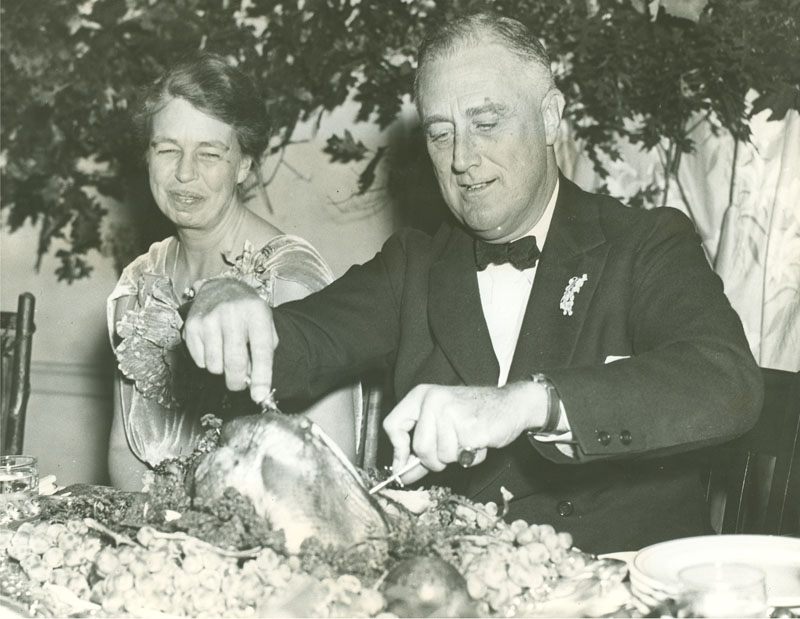For Years, Republican and Democratic States Held Separate Thanksgivings
Before Friendsgiving, there was Franksgiving.

In 1939, President Franklin Delano Roosevelt faced a dilemma. He was responsible for declaring the last Thursday of November to be a day of Thanksgiving—something American presidents had done since Abraham Lincoln began the tradition. But November of 1939 had five Thursdays, which would shorten the holiday shopping season. Retailers still struggling from the Great Depression encouraged him to move Thanksgiving earlier by a week. To the country’s shock, Roosevelt agreed. For the next three years, some states recognized the federal government’s new Thanksgiving date, while others defiantly stuck with the old one.
Roosevelt had rejected previous requests to change the date of Thanksgiving, fearing that he would foil local plans and disrupt football schedules. But according to The New York Times, due to the urging of “department stores, general stores, small stores, and almost every kind of store,” Roosevelt announced on April 14, 1939, that Thanksgiving would be on November 23 instead of the expected November 30.

Angry Americans sent Roosevelt thousands of letters and telegrams about the breach of tradition and their disrupted schedules. An anguished calendar maker from Salem, Ohio, wrote in a letter to the White House that the decision would cause “untold grief” in the industry, since 1939 calendars and many 1940 calendars had already been printed. Just as the White House had predicted, football schedules were scrambled, leading some coaches to vow to vote Republican.
Things quickly became partisan. Several states ignored the presidential proclamation due to tradition or convenience, and others ignored it to snub Roosevelt, a Democrat. This muddled schedules even more. A girl in a New York boarding school wrote Roosevelt on October 18 that her home state, Republican-governed Connecticut, was celebrating Thanksgiving on the later date, making it impossible to go home for the holiday.
In 1939, 22 states celebrated Thanksgiving on the new date, and 23 on the old. But Texas, Colorado, and Mississippi took the best approach: They celebrated Thanksgiving on both dates. Many Americans did the same. In New York City, which celebrated the earlier date, restaurants offered turkey dinners on the “old” Thanksgiving date, too.
Journalists and politicians invented names to mark the confusion. The mayor of Atlantic City called the new date “Franksgiving,” which stuck. Others used the moniker “Democratic Thanksgiving” or “New Deal Thanksgiving,” describing it as another example of the president inappropriately flexing his executive powers.
People were still confused a year later. In 1940, a restaurant sent a telegram to the White House: “CONGRATULATIONS ON YOUR REELECTION. WHEN SHALL WE SERVE OUR THANKSGIVING TURKEY 21ST? OR 28TH?” Only 32 states ultimately celebrated on the new Thanksgiving date. After a survey of 200 stores depicted no real economic benefit, Roosevelt announced that 1942’s Thanksgiving would be held on the original, traditional date.
The president seemed to find his failed Franksgiving experiment funny. The New York Times reported that he seemed lighthearted at the press conference, which was supposed to be about wartime foreign policy. But Congress was less jolly. In October of 1941, the House passed a resolution to make Thanksgiving a public holiday, celebrated on the last Thursday of November regardless of presidential proclamation.

But the resolution was amended when it got to the Senate. Thanksgiving would be celebrated on the fourth Thursday. That way, most Thanksgivings would happen on the last Thursday, without cutting the holiday season short in other years. Still, some states held onto the last-Thursday date for years, sustaining the sense of confusion. In the 1942 movie Holiday Inn, which starred Bing Crosby and Fred Astaire, an animated scene shows a turkey hopping between two potential dates before giving up with a shrug.*

And the two-Thanksgivings phenomenon didn’t end there. In 1944, which featured another five-Thursday November, Florida, Idaho, Nebraska, Texas, Virginia, and Tennessee all celebrated a week after the rest of the country. Texas was the last holdout, observing Thanksgiving on the last Thursday until 1956. Today, Americans all celebrate on the same date, without waiting for a presidential proclamation. In 2017, that’s probably a good thing, because President Trump might have kept the country in suspense.
*Correction: This post previously stated that Frank Sinatra appeared in the film “Holiday Inn.” He did not.
Gastro Obscura covers the world’s most wondrous food and drink.
Sign up for our regular newsletter.

























Follow us on Twitter to get the latest on the world's hidden wonders.
Like us on Facebook to get the latest on the world's hidden wonders.
Follow us on Twitter Like us on Facebook